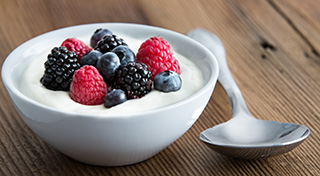U.S. Dairy Products > Yogurt
Yogurt Categories
The U.S. dairy industry manufactures a variety of yogurt products to satisfy a wide range of customer preferences. Categories include spoonable and drinkable products that are plain and/or flavored, with fat levels ranging from nonfat to whole fat. U.S. yogurt products are typically divided into Greek-style and Traditional styles as well as dehydrated yogurt used as an ingredient.
In addition to these primary categories, Australian and Icelandic-style yogurts are also produced in the United States. Each has their own unique taste and texture characteristics and composition. Icelandic yogurts are high in protein like Greek-style yogurts but they tend to be higher in acidity which provides a tarter flavor. Australian yogurts have protein levels closer to traditional yogurts but they are typically made with whole milk which provides a smooth and creamy texture.
Most refrigerated yogurts typically have a shelf life of 45-60 days, as long as they are stored at 4-5°C. All dairy products including yogurt are tested to make sure they are free of pathogens prior to sale.
Traditional and Greek-style yogurt varieties range from plain to flavored and from spoonable to drinkable. Plain yogurt has no added sweeteners, flavors or fruit and it can be enjoyed by itself or it can be used as an ingredient for many culinary applications and baked products. It will provide moisture and flavor to baked products and body, creaminess and flavor to products like soups, sauces, and salad dressings.
Flavored Traditional and Greek-style yogurts are typically sweetened with sugar or with high-intensity non-nutritive sweeteners in the case of lower calorie yogurts. Flavored yogurts are available as a blended product where the fruit and flavors are already mixed in with the yogurt prior to packaging or as a "fruit on the bottom" product with the fruit deposited on the bottom of the cup with the plain yogurt on top. The fruit-on-the-bottom form allows the consumer to mix in the fruit prior to consumption. There's a great variety of yogurt flavors produced in the U.S.; even vegetable, savory and dessert flavors are available. The possibilities are only limited by the consumer's imagination.
No matter the category, all yogurt produced in the U.S. has a standard of identity listed under the Code of Federal Regulations Sec 131.200 through 131.206. It must contain a minimum of 8.25% milk solids nonfat, have a minimum titratable acidity of 0.9%, a pH of 4.6 and contain the lactic acid-producing bacteria, Lactobacillus delbrueckii ssp. bulgaricus and Streptococcus salivarius ssp. thermophilus. Only specified ingredients can be added to yogurt with protein sources limited to dairy based ingredients like fluid milk, nonfat dry milk or whey and cream or milkfat as the source of fat. Other allowable ingredients include cultures, sweeteners, flavorings, stabilizers, and colors.




